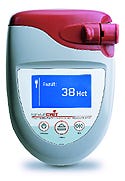May 23, 2007
Originally Published MPMN May 2007
ENGINEERING EXCELLENCE
Blood Measurement Device Draws Praise for Ultrasound Use
|
Using ultrasound technology, the UltraCrit hematocrit measurement device quickly and accurately evaluates the quality of a donor's blood. |
Responding to the desire to help people, the temporary escape from work or school, or maybe just the free snacks afterward, blood donors are helping to save lives regardless of the incentive. But unfortunately, not enough people are finding that reason to sit down and roll up their sleeve. In fact, only 5% of eligible donors in the nation actually donate blood, according to the Mayo Clinic. Meanwhile, the number of transfusions increases 9% annually.
With donors so scarce, ensuring the quality of their blood is critical—that’s where the UltraCrit hematocrit measurement device comes into play. Manufactured by Separation Technology Inc. (Altamonte Springs, FL; www.separationtechnology.com) and developed by Key Technologies Inc. (Baltimore; www.keytechinc.com), the device is the only one of its kind that employs ultrasound technology to calculate red blood cell counts in blood donors. This novel screening method for the blood banking industry boasts a tolerance that is less than or equal to 0.4% hematocrit and has earned the device a Medical Design Excellence Award.
Equipped with a strong background in ultrasound technology, Key Technologies, a high-tech development firm, acquired some seed funding from the National Institutes of Health to pursue development of its brainchild. Though it typically drew most of its business from consulting services, the company took the reins in the design, engineering, development, and some testing phases of the project. Midway through the project, Separation Technology licensed the product and became involved with the remaining development tasks. As a player in the blood banking industry, Separation Technology was able to offer insight as to how the product should look, feel, and operate, according to Ben Lane, lead engineer and designer for Key Technologies.
Use of the device is simple: a technician obtains blood from a donor via a fingerstick or venous method. The sample is placed in a disposable cuvette, which is then inserted into the device. Within 20–30 seconds, the device interrogates the blood using ultrasound technology and yields a hematocrit measurement that is then displayed on the screen. The cuvette is ejected and thrown away.
“I believe the ultrasound approach is more accurate than the competition,” says Lane. “When we developed the device, the big competitors were centrifuge devices, which are inherently not as accurate, and optical devices, which are also not as accurate—or were not at the time.”
The ultrasound penetrates through the entire blood sample several hundred thousand times per second. This differs from optical and centrifuge devices, resulting in an accurate reading, according to Lane. He does point out that laboratory-grade equipment such as a complete blood count test (CBC), on the other hand, counts cells and is considered to be the gold standard of hemoglobin testing. However, Separation Technology claims that the UltraCrit has shown a bias versus a CBC better than 0.4% at three separate user sites.
In addition to the myriad technical challenges the team encountered in relation to ensuring the accuracy of the product, the material surface treatment of the disposable cuvette proved to be especially tough.
“It had to have very specific properties in order to work properly,” Lane explains. “We’re talking about very small amounts of blood, and when you get into very small amounts of fluid, the microfluidics that define how the fluid moves become very complicated.”
Key Technologies called on Conductive Technologies Inc. (York, PA; www.conductivetech.com) to assist with the material surface treatment of the cuvette. Having worked with them in the past, Key Technologies also consulted the company regarding some aspects of the microfluidics of blood flow. Input by CD Product Design (Columbia, MD) in the form of industrial design and user research and interviews rounded out development of the UltraCrit.
Copyright ©2007 Medical Product Manufacturing News
You May Also Like



